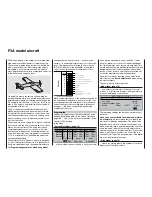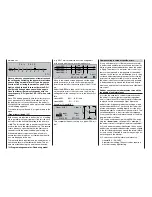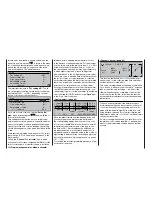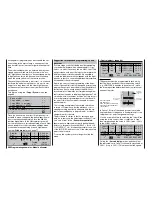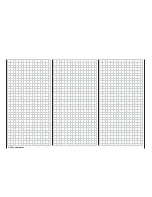
203
governor – which is to be “switched off” at the upper
pre-set of -100% – is actually reliably switched off at
this setting.
A low hover speed of around 1350 rpm is to be set
for the “hover” fl ight phase (Phase 2). This is achieved
as follows: switch to the appropriate fl ight phase and
select “Input 8” again. The current fl ight phase is dis-
played at bottom left on the screen.
Since the inputs 5 … 8 are assigned separately for
each fl ight phase, you should fi rst activate transmit-
ter control assignment and then operate the selec-
ted three-position switch (in our example CONTROL
8) so that the latter is detected by the software. Move
the switch to the “forward” position – which equates to
“speed governor active” – then select the
ASY
fi eld in
the “Travel” column and set the value there to 0%.
+100%
«Hover »
ASY
SYM
ASY
SYM
0%
+100%
0.0 0.0
0%
+100%+100%
+100%
0.0 0.0
0.0 0.0
0.0 0.0
SEL
0%
+50%
Cnt. 8
SEL
0%
+100%
0%
Cnt. 5
offset
–time+
Throt
Gyro
Input
free
free
7
Input
6
–
8
5
Of course, you may wish to change this value, depen-
ding on the type of speed governor you are using. La-
ter you will need to use a rev counter to set the rotor
speed accurately. If you fi nd that you have to set a va-
lue below 0%, it will be necessary to alter the value in
the “offset” column accordingly.
Repeat the procedure in fl ight phase 3 («Aerobat»),
this time with a percentage value of 40% to
provide a high rotor speed for aerobatics. Once again,
this value will vary according to the type of governor
you are using.
203
Programming examples: Model helicopter
+100%
«Aerobat»
ASY
SYM
ASY
SYM
0%
+100%
0.0 0.0
0%
+100%+100%
+100%
0.0 0.0
0.0 0.0
0.0 0.0
SEL
0%
+50%
SEL
0%
+100%
+40%
Cnt. 5
offset
–time+
Cnt. 8
Throt
Gyro
Input
free
free
7
Input
6
–
8
5
This method of programming the speed governor is
comparatively simple, but it does provide a means of
calling up individual fl ight phases which are set to dif-
ferent rotational speeds. The switch must always be
left in the “forward” position. Nevertheless, you can
still switch the speed governor off at any time, in any
fl ight phase, simply by moving the switch to its “back”
position; see »
Servo display
«, Channel 8.
If you have set up your helicopter as described in this
programming example, you will fi nd that it is capable
of carrying out extremely challenging fl ight tasks even
though it is no competition machine. We suggest that
you should not make use of supplementary functions
until your model is fl ying perfectly, so that you will be
in a position to recognise and appreciate any impro-
vements. It is always best to implement additional re-
fi nements one at a time wherever possible, otherwi-
se you won’t know which change has brought about
any improvement. Bear in mind that a good pilot is not
recognised by the number of complex functions with
which he can cope, but by the results he can obtain
when fl ying a helicopter with a relatively simple set-
up.
Summary of Contents for mx-24s
Page 1: ...1...
Page 19: ...19 For your notes...
Page 35: ...35 For your notes...
Page 41: ...41 41 For your notes...
Page 57: ...57 For your notes...
Page 63: ...63 63 For your notes...
Page 69: ...69 69 For your notes...
Page 85: ...85 85 For your notes...
Page 99: ...99 For your notes...
Page 143: ...143 For your notes...
Page 191: ...191 For your notes...
Page 212: ...212 212 For your notes...
Page 213: ...213 213 For your notes...
Page 214: ...214 For your notes...
Page 216: ...216...




